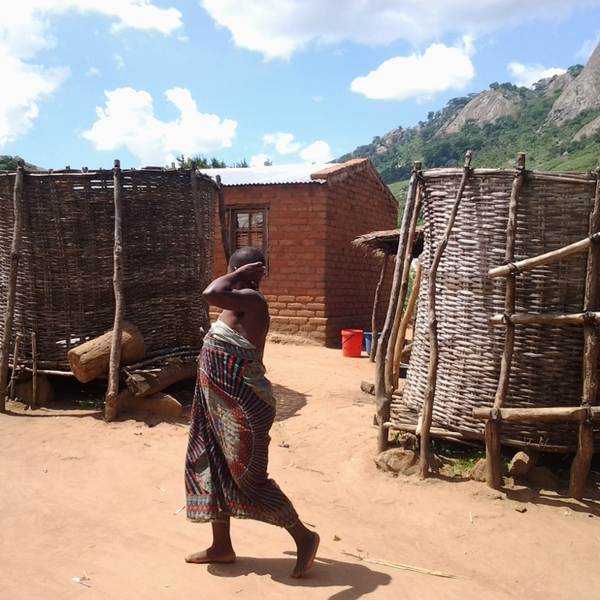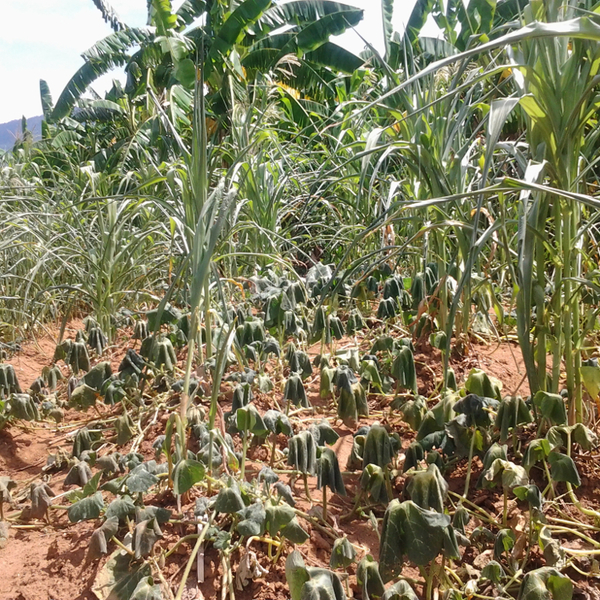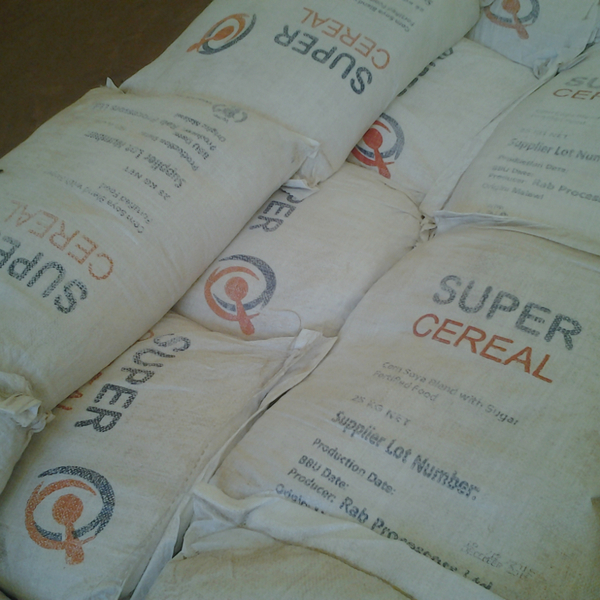Some rain has fallen yet crop yields are still expected to be poor, but aid programmes have opened the door to a more sustainable future.
It’s lunchtime on New Year’s Day 2016 but Ellena Baziliyo has nothing to eat. All there is is water, which she draws from the nearby stream.
Baziliyo, 29, is eight months pregnant. She lives in a small settlement, Kasampha Village, in the Mwanza district in the south of Malawi. Around her, people are doing their usual household chores. Some are selling dried fish. Two of her children are playing in the shadow of an empty maize storage bin, which Baziliyo made from wicker. Almost no one here has a full-time job.
At about 4pm, Baziliyo will start to prepare supper for her family. There are five mouths to feed – herself, her husband and their three children, Frank (13), Maria (10) and Esther (5).
Baziliyo only has maize meal and she’ll make nsima (porridge), Malawi’s staple meal. Each family member will get only one ladle of it. She has to ration all she has got, or it will run out before the end of the week.
Three meals a day is a luxury. “Breakfast and dinner are enough for us,” she says. “At least we won’t die of hunger this way.”

Food relief programme
On January 15, Baziliyo and her family became beneficiaries of World Vision Malawi’s and the World Food Programme’s joint food relief programme. On the 15th day of each of the past three months, they have received a 50kg bag of maize, two litres of cooking oil, six kilograms of soya cereal and six kilograms of cowpea legumes.
Without that, they would have had nothing to eat.
The family are among the 2.83-million people who the Malawi government’s vulnerability assessment committee report of July 2015 projected would run out of food in the “lean season” between October last year and March this year – that is nearly 17% of the country’s population of 16.7 million.
Mwanza is one of 25 districts in the country that have been hit the hardest by the worst famine in a decade. The programme will be stopped at the end of this month, by which time the Malawians are expected to have harvested at least some crops.
The Baziliyos have a half a hectare maize garden and they usually harvest about eight 50kg bags a year.
But the two maize bins in their compound have been empty since October. The maize in their garden is stunted because of severe drought. In some parts in the south of Malawi, there has also been severe flooding, which has destroyed maize and vegetable gardens, depriving many people of their only source of food.
Exposed to natural disasters
Malawi ranks as the 13th worst-performing economy in the world in the 2014-2015 Global Competitiveness report of the World Economic Forum. Most households depend on small-scale farming for food or an income, making them extremely vulnerable to the effects of natural disasters such as dry spells and flooding.
According to Malawi’s department of climate change and meteorological services, there had been far less rain during the 2015-2016 farming year than in the previous one. The rain was also delayed – the first rains only fell in December instead of late October or early November, and then only intermittently.

The department’s director, Jolamu Nkhokwe, says the “extreme drought” is the result of the El Niño phenomenon. “This is the unusual warming of waters over the Eastern Central Equatorial Pacific Ocean, which affects the rainfall pattern over the world, including in Southern Africa, where Malawi is situated.”
Nasa says on it’s website that, during an El Niño occurrence, “the physical relationships between wind, ocean currents, oceanic and atmospheric temperature, and biosphere break down into destructive patterns that are second only to the march of the seasons in their impacts to weather conditions around the world”.
New York’s Columbia University’s Earth Institute, says the phenomenon occurs every two to seven years. The 2015-2016 El Niño has been described as a “super” El Niño and is the worst in 15 years.
Baziliyo’s village and several of its surrounding ones elected the Mpondazi food relief committee to assist the food relief programme to identify the families most in need of emergency assistance.
The committee’s chairperson, Luka Bato, says about 150 families in the area had been helped by mid-January. “There are so many people in need that have not been reached but the officers said that’s what’s available at the moment,” he says.
Baziliyo was identified as a beneficiary because she is pregnant and thus considered vulnerable.
“Last week, I went to the antenatal clinic and the nurse told me that I wasn’t progressing well. My weight had dropped from 62kg to 58 this month,” Baziliyo explains.
“Each time I go for an antenatal visit, the midwife advises me on the importance of a balanced diet. But it’s impossible.”
Families who are headed by widows, lactating mothers, elderly people and those with children under five are also designated as vulnerable and are potential beneficiaries.
The United Nation’s Children’s Emergency Fund reports that, of 103 880 Malawian children under five years who were screened for acute malnutrition in December last year, 886 were diagnosed with severe, acute malnutrition and 4 553 with moderate acute malnutrition.
A healthy diet should contain combinations of fruit, vegetables, grains, meat and dairy products, according to the World Health Organisation.
But Baziliyo says, even after harvests, her family rarely eats any else other than maize. Food is simply too expensive.

Beneficiaries’ details scrutinised
Food aid beneficiaries such as Baziliyo line up at a central point on the 15th of each month to receive their food parcels.
Their identities are verified against photographs, which have been recorded in a register.
They provide fingerprints to acknowledge that they have received their food parcels. Pregnant women and children under five have to prove their status by producing health passport booklets in which their medical histories and ages are recorded at clinics.
Baziliyo says she’s grateful to be one of the beneficiaries. “But I’m still rationing meals because I share my food aid parcel at times.”
One relief worker, who did not want to be named, says: “We advise the beneficiaries not to share their food relief, but they still do because of cultural pressures. One may get labelled evil if you let your neighbours go to bed on an empty stomach. But this is affecting our programme, as it may end up not achieving the intended purpose.”
Some families who don’t qualify for food parcels receive a stipend so that they can buy food.
The World Food Programme country director, Coco Ushiyama, says her organisation recognises that food and nutrition security in Malawi is complex, and that the food aid programme is only addressing the immediate food insecurity needs.

Long-term solutions to vulnerability
But, according to the executive director of the Civil Society Agriculture Network, Tamani Nkhono Mvula, although food aid in general “is not a sustainable option”, as it is only temporarily, it is the best option given Malawi’s current position.
“We are in a famine situation where people don’t have food and money to buy food. Food prices have also gone high due to its scarcity,” he says.
To address food insecurity in the longer term, “beneficiaries of food and cash transfer aid are also integrated into irrigation initiatives, village savings, loan groups and community groups that make energy saving stoves that will offer them some income”, Ushiyama says.
Irrigation initiatives involve teaching small-scale farmers how to get water from nearby rivers to their crops, so that they don’t have rely on rain only. Irrigation also often makes it possible to produce harvests more than once a year.
The initiatives include providing households with treadle and water pumps, and seeds and fertilizer. They are also taught about irrigation techniques, crop production and water management.
Baziliyo, who now has a two-week-old baby whom she breastfeeds, hopes to be more food secure after the harvests from her garden this April. “We are banking on the piece work my husband does in neighbouring Mozambique to put food on the table after the food parcels are phased out at the of the month. Our crops will again be poor because of the dry spell. Meanwhile, there is no other alternative food aid apart from this one,” she says. – Additional reporting by Bhekisisa
Josephine Chinele is a multi-award-winning international journalist. She has worked as a news, features and investigative reporter for newspapers, and radio and television platforms in Malawi, Tanzania and South Africa.





